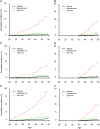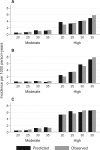Traditional Cardiovascular Risk Factors and Individual Prediction of Cardiovascular Events in Childhood Cancer Survivors
- PMID: 31161223
- PMCID: PMC7073918
- DOI: 10.1093/jnci/djz108
Traditional Cardiovascular Risk Factors and Individual Prediction of Cardiovascular Events in Childhood Cancer Survivors
Abstract
Background: Childhood cancer survivors have an increased risk of heart failure, ischemic heart disease, and stroke. They may benefit from prediction models that account for cardiotoxic cancer treatment exposures combined with information on traditional cardiovascular risk factors such as hypertension, dyslipidemia, and diabetes.
Methods: Childhood Cancer Survivor Study participants (n = 22 643) were followed through age 50 years for incident heart failure, ischemic heart disease, and stroke. Siblings (n = 5056) served as a comparator. Participants were assessed longitudinally for hypertension, dyslipidemia, and diabetes based on self-reported prescription medication use. Half the cohort was used for discovery; the remainder for replication. Models for each outcome were created for survivors ages 20, 25, 30, and 35 years at the time of prediction (n = 12 models).
Results: For discovery, risk scores based on demographic, cancer treatment, hypertension, dyslipidemia, and diabetes information achieved areas under the receiver operating characteristic curve and concordance statistics 0.70 or greater in 9 and 10 of the 12 models, respectively. For replication, achieved areas under the receiver operating characteristic curve and concordance statistics 0.70 or greater were observed in 7 and 9 of the models, respectively. Across outcomes, the most influential exposures were anthracycline chemotherapy, radiotherapy, diabetes, and hypertension. Survivors were then assigned to statistically distinct risk groups corresponding to cumulative incidences at age 50 years of each target outcome of less than 3% (moderate-risk) or approximately 10% or greater (high-risk). Cumulative incidence of all outcomes was 1% or less among siblings.
Conclusions: Traditional cardiovascular risk factors remain important for predicting risk of cardiovascular disease among adult-age survivors of childhood cancer. These prediction models provide a framework on which to base future surveillance strategies and interventions.
© The Author(s) 2019. Published by Oxford University Press. All rights reserved. For permissions, please email: journals.permissions@oup.com.
Figures


References
-
- Lipshultz SE, Adams MJ, Colan SD.. Long-term cardiovascular toxicity in children, adolescents, and young adults who receive cancer therapy: pathophysiology, course, monitoring, management, prevention, and research directions: a scientific statement from the American Heart Association. Circulation. 2013;128(17):1927–1995. - PubMed
Publication types
MeSH terms
Grants and funding
LinkOut - more resources
Full Text Sources
Medical

